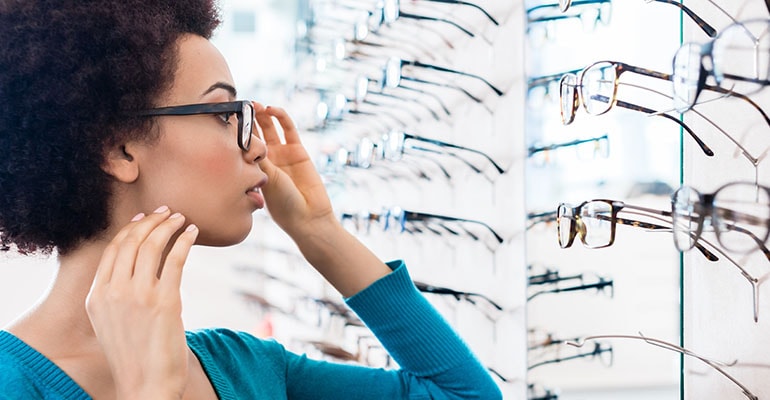Types of Glasses | An Overview of Styles and Functions
Apr 25, 2024

Glasses serve a dual function, both as vision correction tools and fashion accessories, catering to a wide variety of eyesight needs and aesthetic preferences. With advancements in optical technology, glasses have evolved from mere vision aids into statements of style, making choosing the right pair an important decision for both appearance and comfort.
The assortment of available glasses spans numerous types, with frames crafted from materials such as lightweight plastics, durable metals, and even eco-friendly options like wood or bamboo. This material diversity not only dictates the weight and durability of the glasses but also influences their overall aesthetic. Different lens shapes can complement facial features, while lens types accommodate various vision corrections, from single-vision lenses to more complex bifocals or progressives.
Styles of glasses range from timeless designs like the classic wayfarer to modern minimalist frames that suit a spectrum of personal tastes and lifestyles. Whether the goal is to make a fashion statement, provide comfort during extensive screen time, or enhance visual clarity, there exists a type of glasses to fit every individual's needs and preferences.
Types of Lenses
Choosing the right lenses for your glasses is crucial for ensuring optimal vision and comfort. This section addresses the varieties of lenses available and the materials and coatings used to enhance their function.
Single-Vision Lenses
Single-vision lenses are designed to correct one field of vision: near, intermediate, or distance. They are the most common type of prescription lenses used by individuals who have specific visual correction needs such as myopia or hyperopia.
Bifocal and Trifocal Lenses
Bifocals have two distinct optical powers to correct vision at different distances, typically allowing for a seamless transition from distance viewing on the top to near vision at the bottom. Similarly, trifocals incorporate an additional segment for intermediate vision.
Progressive Lenses
Progressive lenses offer a gradient of multiple vision fields, from distance to near, without visible lines on the lens. They provide a more natural visual experience compared to bifocals or trifocals but may require an adaptation period for some wearers.
Lens Materials and Coatings
The materials used in lenses such as polycarbonate, high-index plastic, and Trivex vary in properties like weight, thickness, and impact resistance. Glass lenses are less common due to their weight and fragility. Most lenses come with additional options for lens coatings including anti-reflective, scratch-resistant, and UV protection to enhance durability and visual clarity. Plastic lenses are often chosen for their lightweight and shatter-resistant qualities.
Frame Designs and Materials
Selecting the proper frame design and material is crucial for comfort, durability, and style in eyewear. Each choice reflects personal taste and has different advantages.
Full-Rim and Semi-Rimless Frames
Full-rim frames encase the entire edge of the lenses, providing maximum protection and a defined look. They are versatile and the most common style, found in a wide variety of shapes. Semi-rimless frames, also known as half-rim frames, support the lenses from the top or bottom only. This design reduces the weight of the glasses and offers an understated, sophisticated appearance.
Rimless Frames
Rimless frames are characterized by lenses that are directly attached to the bridge and temples with very minimal hardware, creating a virtually invisible look on the face. They are lightweight and more fragile than their full or semi-rimless counterparts but are preferred for their nearly unnoticeable presence and elegance.
Material Options for Frames
Materials used in eyewear need to balance flexibility, weight, and strength. Metal frames made of stainless steel, aluminum, titanium, or Monel offer a sleek, refined aesthetic and are valued for their durability and corrosion resistance. Plastic frames, often crafted from acetate, are lightweight and provide a variety of color options. Titanium frames stand out for their superior strength-to-weight ratio and hypoallergenic properties.
Eyewear for Vision Correction
Choosing the appropriate eyewear for vision correction is essential to ensure comfortable and precise vision enhancement. Clear vision impacts daily activities and quality of life, therefore, understanding the various options available for differing refractive errors is important.
Presbyopia Solutions
Presbyopia, the age-related difficulty in focusing on close objects, can be addressed with reading glasses or progressive lenses. Reading glasses provide a single vision correction that is optimal for near tasks, while progressives offer a gradient of varying strengths suitable for distances from close to afar.
Myopia and Hyperopia Options
To correct nearsightedness (myopia) or farsightedness (hyperopia), prescription glasses with single-vision lenses are typically used. These prescription lenses are specifically crafted to correct the visual acuity whether one has difficulty seeing far away or up close. Single-vision lenses are designed to treat either condition but not both simultaneously.
Eyewear for Astigmatism
Astigmatism, a condition where the eye's cornea or lens is irregularly shaped, necessitates special prescription lenses for clear vision. These lenses, known as toric lenses, are necessary to correct the distorted vision caused by astigmatism. Individuals with astigmatism must have their prescription accurately measured to avoid blurriness at any distance.

Glasses for Specific Uses
Glasses serve a variety of specific purposes beyond correcting vision. The particular uses of glasses dictate their design and features, such as filtering light, providing protection from impact, or enhancing comfort during prolonged screen time.
Computer and Blue Light Glasses
Computer glasses and blue light glasses are crafted to reduce eye strain for individuals who spend extended periods in front of screens. With lenses that block or filter blue light, they mitigate potential disruption to sleep cycles and lessen digital eye strain. These glasses often have anti-reflective coatings to minimize glare, enhancing focus and comfort during computer use.
Sunglasses
Sunglasses are essential for protecting eyes from the sun's harmful UVA and UVB rays. Many sunglasses come with polarized lenses to reduce glare, making them particularly useful for activities like driving or water sports. They can be found in various styles and materials, with options to suit both fashion preferences and functional needs, such as wraparound lenses for greater eye coverage.
Safety and Sports Eyewear
Durable safety glasses and sports eyewear are designed to protect the wearer's eyes from impact and debris. Safety glasses often have robust polycarbonate lenses and are tested to meet rigorous safety standards. Sports eyewear is similarly constructed to withstand high-speed encounters, provide a secure fit during vigorous activity, and offer clear vision simultaneously.
Choosing the Right Glasses
Selecting the ideal glasses involves more than just lens prescription. One should consider their face shape, comfort needs, and personal style to ensure an ideal match.
By Face Shape
When choosing glasses, one must consider their face shape to select a frame that best complements their features. Oval faces, characteristically balanced, often work well with most frame styles, while rectangular frames can add structure to a round face. Those with square faces may find round or oval glasses soften their angular features, and heart-shaped faces can balance their proportions with low bridge fit frames or styles that are wider at the bottom.
Considering Weight and Comfort
Comfort is key in eyewear, and weight plays a significant role. Lightweight materials such as titanium can provide comfort, especially for those who wear glasses for extended periods. Considering the weight distribution—from the front of the glasses to the temples and nose pads—is crucial. Adjustable nose pads and temple tips can enhance fit, lessening pressure points for a comfortable wearing experience.
Color and Aesthetic Choices
The colors and aesthetic of glasses frames should complement both the wearer's complexion and personal style. For a minimalist look, one might choose solid, neutral colors, while brighter hues can express a bolder style. Selecting the right colors can enhance the wearer's appearance, complementing eye color and skin tone. Glasses styles should also reflect the individual's lifestyle—options range from professional to casual, catering to various aesthetic preferences and budgets.